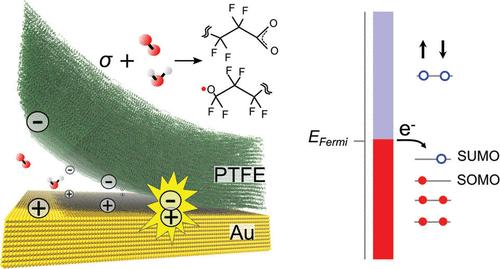Oxidized Mechanoradicals Drive Triboelectricity in Polytetrafluoroethylene: A First Principle Understanding
IF 3.2
3区 化学
Q2 CHEMISTRY, PHYSICAL
引用次数: 0
Abstract
Although triboelectricity has played a crucial role in mankind’s discovery of charges and is of high relevance in different technological fields, the underlying mechanisms remain elusive. Even the type of charge carriers transferred─electrons, ions, or material fragments─is still controversial. One of the most relevant triboelectric materials is polytetrafluoroethylene (PTFE) due to its extremely high tendency toward negative triboelectric charging. Since PTFE is a chemically very stable insulator with a large band gap, the question arises how it stabilizes charges during contact electrification. Here, we use density functional theory and GW to clarify how the charge transfer between PTFE and gold surfaces takes place. During tribological contact, PTFE suffers mechanochemical bond cleavage. However, the resulting C-centered radicals are not electron affine enough to explain negative charging. Our GW calculations suggest that more electronegative alkoxy and carboxylate defects, which form from C-centered radicals in the presence of O2 and H2O, are required for stable integer electron transfer. A simple model based on electrostatics and quantum-mechanical tunneling explains how charging of these defects is preserved during contact separation.

氧化机械自由基驱动聚四氟乙烯摩擦电:基本原理的理解
尽管摩擦电在人类发现电荷的过程中发挥了至关重要的作用,并且在不同的技术领域具有高度的相关性,但其潜在的机制仍然难以捉摸。即使是所转移的载流子类型──电子、离子或材料碎片──也仍存在争议。聚四氟乙烯(PTFE)是最相关的摩擦电材料之一,因为它具有极高的负摩擦电荷倾向。由于聚四氟乙烯是一种化学上非常稳定的绝缘体,具有很大的带隙,因此问题出现了它如何在接触带电过程中稳定电荷。在这里,我们使用密度泛函理论和GW来阐明PTFE和金表面之间的电荷转移是如何发生的。在摩擦学接触过程中,聚四氟乙烯遭受机械化学键解理。然而,由此产生的c中心自由基的电子仿射性不足以解释负电荷。我们的GW计算表明,在O2和H2O存在下,由c中心自由基形成的更多电负性烷氧基和羧酸盐缺陷需要稳定的整数电子转移。一个基于静电和量子力学隧道的简单模型解释了在接触分离过程中这些缺陷的电荷是如何保存的。
本文章由计算机程序翻译,如有差异,请以英文原文为准。
求助全文
约1分钟内获得全文
求助全文
来源期刊

The Journal of Physical Chemistry C
化学-材料科学:综合
CiteScore
6.50
自引率
8.10%
发文量
2047
审稿时长
1.8 months
期刊介绍:
The Journal of Physical Chemistry A/B/C is devoted to reporting new and original experimental and theoretical basic research of interest to physical chemists, biophysical chemists, and chemical physicists.
 求助内容:
求助内容: 应助结果提醒方式:
应助结果提醒方式:


